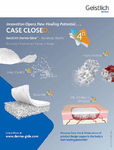Age-Based Inter-Subject Variability in Platelet and Whiteblood Cell Concentrations of Platelet-Rich Plasma Preparedusing a New Application to Blood Separation System

Use this link to cite
http://hdl.handle.net/2183/29520
Except where otherwise noted, this item's license is described as Atribución-NoComercial 4.0 Internacional
Collections
- Investigación (FEP) [507]
Metadata
Show full item recordTitle
Age-Based Inter-Subject Variability in Platelet and Whiteblood Cell Concentrations of Platelet-Rich Plasma Preparedusing a New Application to Blood Separation SystemAuthor(s)
Date
2021-06Citation
Trevisson, B, Becerro-de-Bengoa-Vallejo, R, Sevillano, D, et al. Age-based inter-subject variability in platelet and white blood cell concentrations of platelet-rich plasma prepared using a new application to blood separation system. Int Wound J. 2022; 19( 2): 362– 369. https://doi.org/10.1111/iwj.13636
Abstract
[Abstract] The benefit of autologous platelet-rich plasma (PRP) treatment is still underdiscussion. Variations in PRP products, consequence of the lack of astandardised protocol for the multitude of commercially available blood sepa-ration systems and the lack of knowledge of the optimal composition of PRPor its suitability for the proposed indication are some of the reasons behindclinical inconsistencies. The impact of inter-subject variability in PRP hasreceived less attention in comparison. The purpose of this study was to deter-mine the inter-subject variability, based on age, in the concentrates preparedby a new blood concentration system. Twenty-six healthy volunteers of bothgenders (29-93 years) were enrolled. Whole blood (WB) was collected fromeach participant to prepare PRP using the Easy PRP kit. Platelets and whiteblood cells (WBC) from WB and PRP were analysed after split population byage; patients younger than 65 years (n=13) and patients≥65 years old(n=13). Among the demographic characteristics tested, only age was signifi-cantly different between the groups. Cell capture efficiency of the system wasspecific for each type of blood cell and identical for both age groups. Plateletsand WBC in PRP were higher than in WB (P< .001). In WB, platelets andWBC concentrations were significantly lower in older group (P≤.035). Thesedifferences persisted in the prepared PRP (P≤.004). The ageing of populationhas a strong influence on the haematocrit and therefore on the composition ofPRP. Because the efficiency of blood separator system seems to be constantacross individuals, the inter-subject haematocrit variability based on age couldbe used as a predictor of resulting PRP. The clinical application of PRP shouldbe restricted to the specific cell capture capacity of the different commercialdevices
Keywords
Blood
Sangre
Leukocytes
Leucocitos
Platelet-rich plasma
Plasma rico en plaquetas
Sangre
Leukocytes
Leucocitos
Platelet-rich plasma
Plasma rico en plaquetas
Editor version
Rights
Atribución-NoComercial 4.0 Internacional






